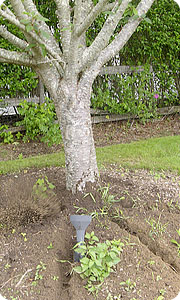Soil Compaction Treatments
Most soils in the Greater Cincinnati area are compacted to some degree. Due to the large amount of clay on most of our properties tree roots often struggle to get the water and oxygen needed for optimal growth and health. There are several different methods used to aerate soil to optimize conditions for root growth.
Our most frequently used methods are:
Fertilizing & Root Zone Aeration
Fertilizing is an easy way to help your trees build stronger defenses against infection by adding an extra boost of minerals and nutrients which may not be otherwise present in the soil. Root zone aeration is used in situations where the soil surrounding a tree has been severely compacted. Soil compaction is often a by-product of construction, but it can also be caused by many years of foot traffic and car traffic, among other things. Compacted soil does not allow roots to readily absorb nutrients, rather, the ‘food’ that the tree needs runs off the surface of the soil. Our soil injection fertilizing both provides needed nutrients to the compacted soil and aerates the soil at the same time, enabling better nutrient absorption.
Vertical Mulching
In addition to Fertilizing and Root Zone Aeration, vertical mulching can increase gaseous exchange in the root system of a tree. Compaction, trenching and changes in grade can all lead to conditions where tree roots no longer get the oxygen that they need to support life. Vertical mulching is a process by which a non-porous matter, such as gravel is installed in columns, below the surface of the soil. Gasses can freely exchange in this medium and it is not visible from the surface. Our staff can create a façade of grass, mulch, or whatever it is that you desire.
Please note: Our Certified Arborist will know the appropriate amount of material required and the exact location where it should be distributed. Attempting vertical mulching on your own can destroy tree roots beyond repair and cause the demise of your tree.
Radial Trenching
Radial trenching is a more involved process than vertical mulching. It entails removing the soil around a tree in a wagon wheel pattern and replacing the soil with an amendment, along with some of the native soil. The width, depth and quantity of spokes made vary depending on the severity of compaction and the arborist’s recommendations for each situation. This process replaces significant amounts of soil and can be used on established trees or for new plantings in challenging sites.



